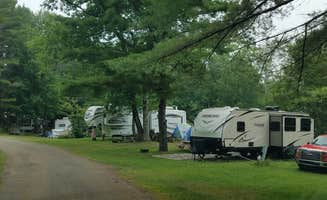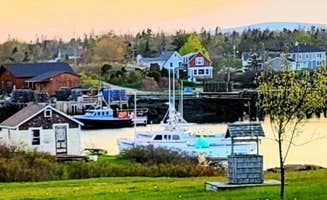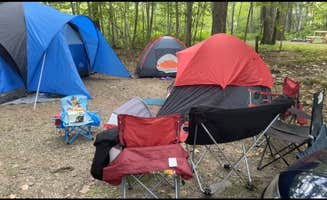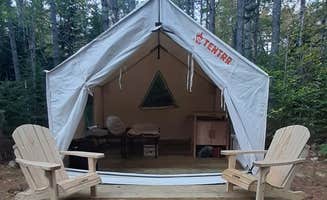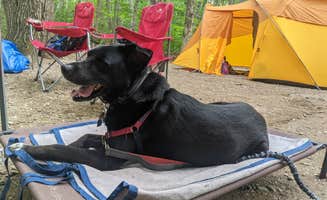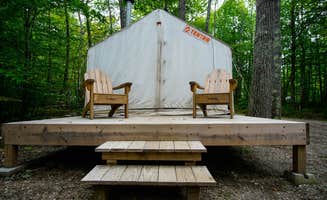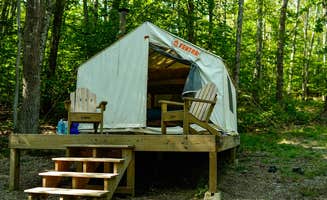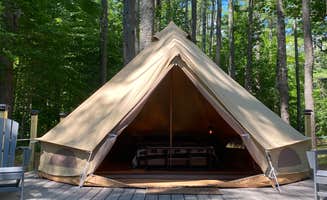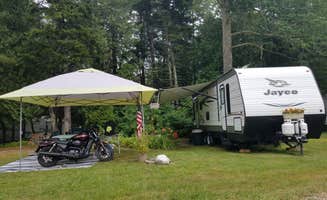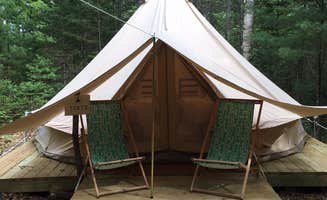Camping sites near West Rockport, Maine sit within the Mid-Coast region at elevations ranging from sea level to 800 feet at nearby Mount Battie. The coastal landscape transitions from rocky shorelines to inland lakes and forested areas. Most local campgrounds operate in a relatively short season from May through mid-October due to the region's cold winters, with average summer temperatures ranging from 55-75°F.
What to do
Kayaking from shore sites: Lobster Buoy Campsites offers direct water access for paddlers. "The kayaking from here is awesome. Owners are super friendly and the spot is ideal," notes Annie G. The South Thomaston location provides protected paddling areas suitable for beginners to advanced kayakers.
Mountain hiking access: Several campgrounds offer direct trail connections. "One of the real pluses of this park were the miles and miles of hiking trails just outside our doorstep," mentions Nancy W. about Camden Hills State Park. Most trails range from easy 1-mile loops to more challenging 3-4 mile ascents with significant elevation gain.
Farm activities: For a different camping experience, smaller operations like Continuous Harmony Farm provide agricultural activities. "Pick your own blueberries alongside their raking crew in their organic wild blueberry barrens," explains Ashley F. This experience is available only during the late July-early August blueberry season and requires an additional fee.
What campers like
Cedar shower facilities: Megunticook by the Sea Campground receives consistent praise for its unique shower facilities. "The cedar showers are awesome! We've been excited to come back here since we left," says Chelsea. These wood-lined shower facilities provide hot water and a distinctive outdoor feel.
Community gatherings: Several campgrounds offer organized social activities. "They had a band play on Saturday night and large bonfire. Everyone was invited to attend if they wanted to," writes Rachel S. about Duck Puddle Campground. Many campgrounds host weekly events during peak summer season, typically between late June and Labor Day.
Oceanfront common areas: Even without waterfront sites, many campgrounds provide shared water-access spaces. "The deck on the ocean is a great place to picnic," notes Kevin W. about Megunticook by the Sea. These common areas often include fire pits, picnic tables, and seating areas facing the water.
What you should know
Site reservation strategies: Many campgrounds use split reservation systems. "Reservations can be made online but only about half of the sites are reservable leaving the other half for walk-ups," explains Nancy W. about Camden Hills State Park Campground. For weekend camping between July 4th and Labor Day, booking 2-3 months in advance is typically necessary.
Additional fees: Some campgrounds charge supplemental costs beyond base rates. One camper noted at Megunticook Campground: "I thought $50 for a tent site was a little steep but it was all the potential extra fees that irked me: $30 site lock to ensure you get the site you want when you reserve... $4 weather guarantee... $7.95 if you need to hook up to WiFi."
Varied site privacy: Site separation varies significantly between campgrounds and within the same facility. "Sites vary from those that accommodate RVs with water and electric to those for tents. For the most part, sites are grassy with a picnic table and a fire ring," observes Nancy W. about Lobster Buoy Campsites. Wooded sites typically offer more privacy than open field locations.
Tips for camping with families
Lakeside swimming options: Sennebec Lake Campground provides dedicated swimming areas for children. "We love the proximity to the lake with easy access for kayaking and swimming," writes Pam A. The gradual lake entry makes it suitable for younger children, with the swimming area typically open from late June through early September.
Indoor recreation spaces: For rainy day activities, some campgrounds offer covered facilities. "Bathrooms/showers are clean and not very busy as most guests are in RVs. There is a small arcade, store, and 24/7 laundry," mentions Pam A. about Sennebec Lake Campground. These facilities provide alternatives when outdoor activities aren't possible.
Playground accessibility: Check campground maps for proximity to play areas. "The playground is a bit of a stretch," Jimmy M. notes about Camden Hills State Park Campground. Many families prefer sites 20-40 at campgrounds with play areas to allow easier supervision while still maintaining some campsite privacy.
Tips from RVers
Tree clearance challenges: Several local campgrounds have mature tree growth. "Lots of tall pine trees provide shade but also make it a little difficult to navigate the roads. We had to go pretty slow to avoid hitting tree branches," warns Nancy W. about Camden Hills RV Resort. RVs over 30 feet should request detailed site information before booking.
Internet connectivity options: Cellular and WiFi service varies significantly. "We decided not to shell out the money but since we did not get a strong Verizon signal, internet access was pretty much non-existent," reports Nancy W. Most campgrounds offer paid WiFi services ranging from $5-8 per day, with stronger connections typically available near main buildings.
Site leveling requirements: Many campgrounds feature natural terrain with minimal grading. "Not all sites in the campground are level and the roads were in pretty bad shape so plan on going slow through the potholes," cautions Nancy W. about Lobster Buoy Campsites. Bringing additional leveling blocks is recommended, particularly for RVs over 25 feet.


